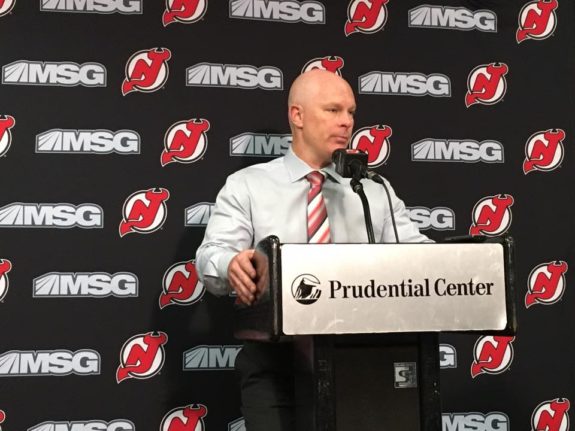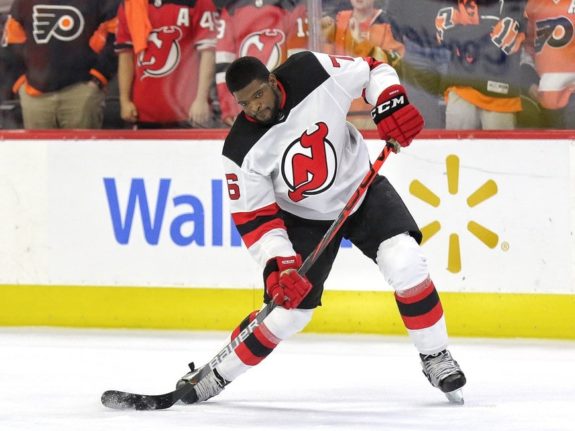The New Jersey Devils haven’t gotten off to the start that many expected. They’re 0-3-2 in their first five games, have been shutout twice, and have not looked competitive a majority of the time. To make matters worse, their special teams have been abysmal, and they’ve blown two late third-period leads that each cost them a shot at their first win.
No one clinches a playoff berth by going 5-0-0 in October. But things can unravel in a hurry if you get off to a poor start, and that’s where the Devils are at this point. Criticism is fair for everyone on the team, the players included. But it starts with head coach John Hynes, who’s feeling the heat less than two weeks into the season.
Devils’ Bad Start Is Not Bad Luck
To say it hasn’t been a great start for the Devils isn’t doing it justice. Things were looking up in the team’s first game, as they got off to a 4-0 lead against the Winnipeg Jets. But the wheels came off in the final 20-plus minutes, with the Devils giving up four unanswered goals. They eventually fell in the shootout, losing the game 5-4.
Since then, it’s all been downhill. They were run out of the building by the Buffalo Sabres by a score of 7-2. On Wednesday night, they took on the Philadelphia Flyers and got buried 4-0. They put up a better performance against the Edmonton Oilers but could not hold a third-period lead and once again lost in a shootout. It all culminated with yet another shutout loss last night, this time at the hands of the Boston Bruins.

It’s one thing to play well and be the victim of bad luck. But that has been far from the case for the Devils. Except for their performance against the Oilers, they have struggled at five-on-five. Here’s where their Corsi for percentage (CF%), expected goals for percentage (xGF%), scoring chances for percentage (SCF%), and high-danger chances for percentage (HDCF%) rank in the league:
- CF%: 47.63% (24th)
- xGF%: 48.64% (20th)
- SCF%: 45.21% (25th)
- HDCF%: 47.69% (23rd)
Five games may be a small sample size, but the Devils’ shot rates over the last three-plus seasons paint a more telling picture. Since 2016, the Devils have the fifth-worst CF% and seventh-worst xG. They also have the eight-worst SCF%; although, their HDCF% is 13th best. Still, that’s not a ringing endorsement of the system the team is running under Hynes.
The Devils’ shot rates this season are about inline where they’ve ranked over the last three seasons, too. Even when the team made the playoffs in 2017-18, they finished with a 48.59 CF%, ranked 11th-worst in the league, and had an xGF% of 50.01, ranked 14th-worst. An MVP season by Taylor Hall helped mask some of their flaws, as well as some incredible goaltending by Keith Kinkaid down the stretch.
Devils’ Special Teams Aren’t Helping
If you aren’t playing well at five-on-five, then your special teams better help pick up some of the slack. Unfortunately, the Devils’ special teams have been worse than their five-on-five play. Their power play is operating at a 0% success rate in 15 tries, while the penalty kill has only succeeded 50% of the time. As you may have guessed, those are last in the league.
After the offseason additions of Nikita Gusev, Wayne Simmonds, and P.K. Subban, the Devils were expected to have a much-improved man advantage from 2018-19. But it’s been anything but that through five games. Their zone entries have been a mess, and when they do successfully gain the offensive zone, their puck movement has been slow. That’s led to trouble creating quality shots and scoring chances.

There’s no reason for the power play to look this out of sync. They may be working in new players like Subban and Gusev, but they’ve also had a month, with the preseason, to get things in order. With that said, the power play under Hynes has not been great during his tenure, either. Like at five-on-five, they’ve ranked in the bottom ten in shots and chances per 60 minutes. So a quick fix could prove difficult.
The penalty kill’s struggles, on the other hand, have been a surprise. The Devils had a top-five kill last season, and much of its personnel remain on the team. Its issues were the focal point of their loss against the Oilers, where the Devils outscored the Oilers 3-1 at five-on-five but were just one for three killing penalties. If they don’t turn things around on the kill, it’ll be hard to win many games regardless if they improve elsewhere.
Hynes’ Questionable In-Game Management
The Devils may not be playing well, but Hynes hasn’t helped his case with his personnel management. And there are a few instances of this occurring.
We’ll start with the Devils’ lineup against the Sabres. His most notable decision was to begin the game with a line of Miles Wood, Jack Hughes, and Jesper Bratt. The results were not pretty, as the Devils were out-attempted 2-10 with them on the ice. It’s also worth mentioning that Hynes never broke up that trio, or any of his other combinations, despite the team trailing for the entire game.
The lines were different against the Oilers, and the team benefited from the changes, as they controlled play at five-on-five. But two players who should have seen more ice time, Gusev and Bratt, finished regulation with barely 10 minutes played. And that’s all the more puzzling after they connected on a beautiful goal to give the team a 2-1 lead in the second period. Both players ended up in the bottom three in ice time for the game.

Last night’s game saw the Devils roll with the same lines. They played fairly well but couldn’t get one by a white-hot Tuukka Rask. However, players like Hughes, Bratt, and Gusev finished with less five-on-five minutes than Kevin Rooney, Pavel Zacha, and Wayne Simmonds. With all due respect to the latter three, they should not be logging more ice time than Hughes, Bratt, and Gusev when the team is trailing 3-0.
And, of course, there’s Hynes’ decision to switch up the lines when the team was leading 4-0 against the Jets. A Jets’ goal with 10 seconds left in the second period isn’t ideal. But to mix things up to start the third period may have been a panic move, especially since things were pretty even at five-on-five. Hynes swapped Bratt with John Hayden on a line with Hughes and Gusev, and they were on the ice for two of the Jets’ three third-period goals. If he wanted defensive stability, placing Blake Coleman on that line instead of Hayden would’ve been a better choice.
Devils’ Future Hangs in the Balance
To say this is a crucial season for the Devils would be an understatement. Hall is in the final year of his contract and could become an unrestricted free agent in July. How the team does this season will have a big say in him signing a lucrative extension with the team. A poor start won’t change what general manager Ray Shero decides to do with Hall, but it can’t drag on much longer.
Related: Devils Still Seeking Right Lineup
The importance of being in a playoff spot early in the season can’t be stressed enough. From 2013-2018, 75% of teams in a playoff spot at American Thanksgiving have gone on to remain in that spot at season’s end. If the Devils are going to shake things up, it’d be best to not wait until after then. They play their next six games at home, so it’s a good chance to get things back on track. If they remain below .500 once their homestand ends, then Shero should look to make a change.
* * *
Advanced stats from Natural Stat Trick